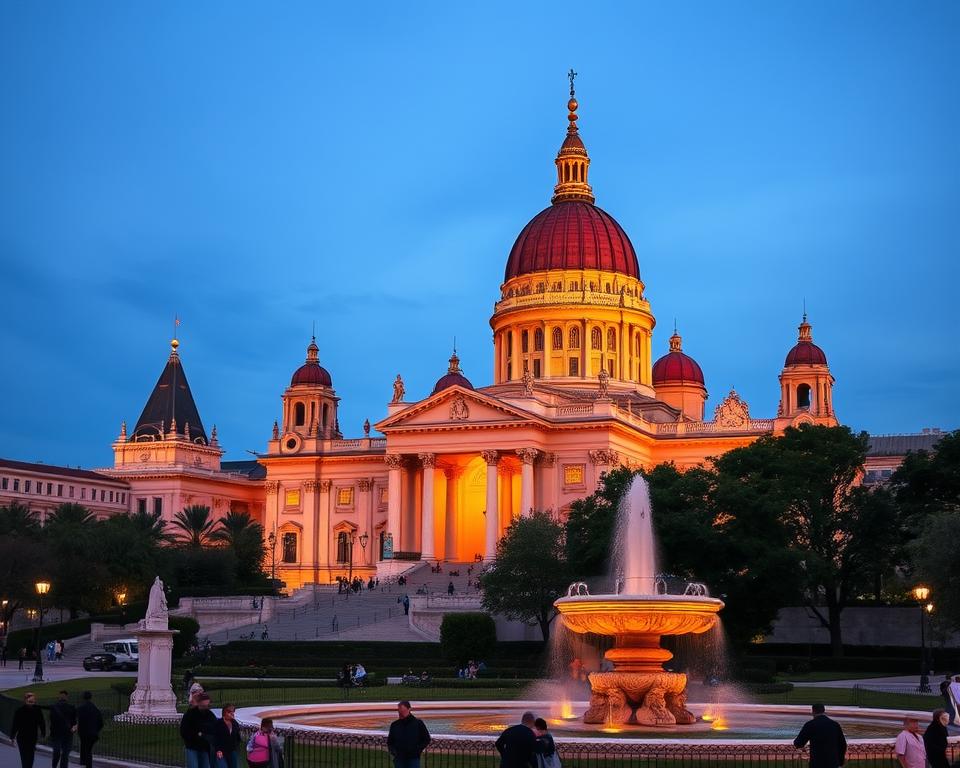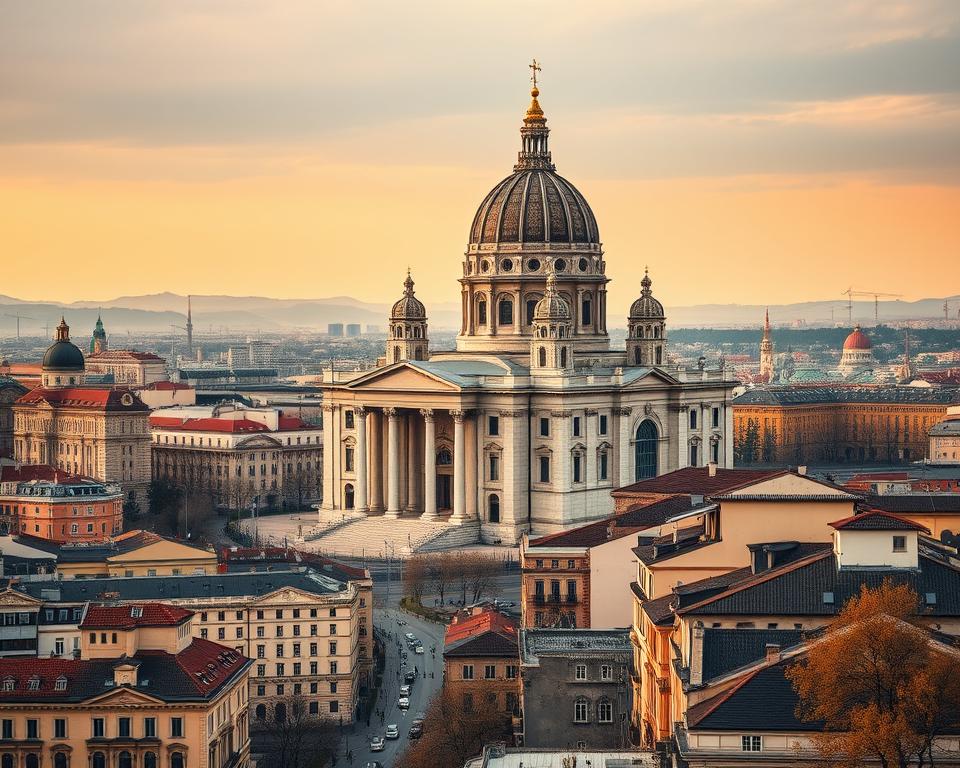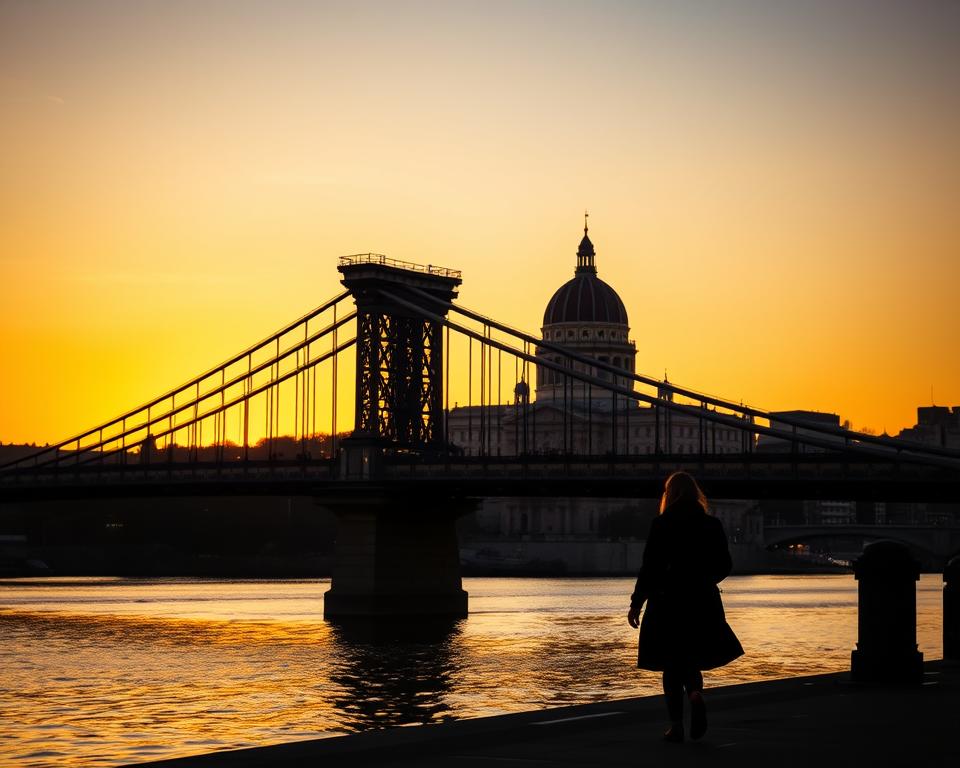
In the heart of Budapest, St. Stephen’s Basilica shines as a symbol of Hungary’s deep culture and faith. This grand Roman Catholic cathedral honors King Stephen I, Hungary’s first ruler. It’s a place of beauty and faith that draws people from all over the globe.
Read interesting things at : web-quanto
Key Takeaways
- St. Stephen’s Basilica is a renowned Roman Catholic cathedral in Budapest, Hungary.
- The basilica is named after King Stephen I, the first king of Hungary, and is a symbol of the country’s religious and cultural legacy.
- The cathedral’s impressive architecture blends Gothic and Neoclassical styles, creating a stunning visual experience.
- Visitors can explore the basilica’s interior, admire the intricate artwork and religious artifacts, and climb to the observation deck for breathtaking views of the city.
- St. Stephen’s Basilica is a must-visit destination for anyone exploring the rich heritage and landmarks of Budapest.
Unveiling the Majestic St. Stephen’s Basilica
The beauty of St. Stephen’s Basilica shows the skill and faith of the Hungarian people. It started in 1851 and took more than 50 years to finish, ending in 1905. The mix of gothic architecture and Neoclassical styles makes it a sight to behold.
The basilica’s tall facade and high spires grab your attention. The stunning blend of architectural styles is amazing. The gothic and neoclassical elements work together perfectly. Visitors are amazed by the detailed stonework and decorations outside.
In the heart of Budapest, St. Stephen’s Basilica shows the city’s deep history and culture. Matthias Church and Fisherman’s Bastion add to its beauty and importance.
“St. Stephen’s Basilica is a true masterpiece, a harmonious fusion of architectural styles that leaves a lasting impression on all who behold it.”
St. Stephen’s Basilica is a top sight in Budapest, drawing visitors from everywhere. Its lasting beauty and skill show the Hungarian spirit and culture.
Architectural Marvels: A Journey through Gothic Grandeur
When you enter Budapest, the stunning spires and detailed stonework of St. Stephen’s Basilica grab your attention. This architectural wonder shows off the lasting beauty of Gothic style. It mixes classic Gothic with Neoclassical touches, making it both grand and beautiful.
Towering Spires and Intricate Stonework
The basilica’s high spires seem to touch the sky, drawing your gaze upwards. They’re filled with detailed carvings and beautiful designs. These spires show the amazing skills of the builders and stone carvers. The outside walls are covered in intricate designs, making you feel amazed and curious.
The Masterful Blend of Styles
St. Stephen’s Basilica is a mix of Gothic and Neoclassical styles. The Neoclassical touches, like the big dome and balanced layout, work well with the Gothic parts. This mix makes the building look beautiful and well-planned.
The mix of Gothic and Neoclassical at St. Stephen’s Basilica shows the lasting impact of gothic architecture. It’s thanks to the hard work of skilled artists over the years. When you see the cathedral’s inside and its tall spires, you feel like you’ve stepped back in time. Here, art, faith, and engineering come together to create something truly special.
“The basilica’s soaring spires, reaching towards the heavens, are a striking feature that immediately command attention.”
Historical Significance: A Cornerstone of Hungarian Faith
St. Stephen’s Basilica is very important to Hungarians. It was built to honor King Stephen I, the first king of Hungary. This king helped make Hungary Christian and started the Hungarian state. So, the basilica is a key symbol of Hungary’s faith and culture.
The building of St. Stephen’s Basilica started in 1851 and finished in 1905. This shows the long effort of the Hungarian Catholic Church to grow in the area. The basilica’s design and details show respect for Hungary’s history and the people’s strong faith.
Now, the St Stephen’s Basilica draws visitors from all over the world. They come to see its spiritual and historical value. As a national treasure, it shows the strength and faith of the Hungarian people. It reminds us of Hungary’s deep cultural and religious past.
“St. Stephen’s Basilica is not just a magnificent structure; it is a living embodiment of the Hungarian spirit, a testament to the unwavering faith that has guided our nation through the ages.”
St. Stephen’s Basilica: The Crown Jewel of Budapest
St. Stephen’s Basilica is a stunning Budapest landmark. It’s seen as the city’s top architectural and cultural gem. Named after Hungary’s first king, it draws visitors with its stunning inside, filled with amazing religious art and craftsmanship.
Awe-Inspiring Interior Splendor
When you enter the st stephen’s basilica, you’re hit with its grand beauty. Walls are covered in detailed mosaics, and the marble altars and a big dome seem to touch the sky. This place shows the deep faith and artistic skill of the Hungarian people, leaving visitors feeling awed and respectful.
“The st stephen’s basilica is a breathtaking display of religious art and craftsmanship, a true masterpiece that captures the essence of Hungarian faith and culture.”
The st stephen’s basilica is full of intricate details and grandeur. It shows the devotion and creativity of the Hungarian people. It’s a key spot for anyone wanting to see Budapest’s rich cultural heritage.
Exploring the Sacred Relics and Treasures
St. Stephen’s Basilica is more than just a beautiful building. It’s a place filled with sacred relics and treasures that mean a lot to many people. When you walk inside, you feel the history and spiritual depth of the place.
The basilica keeps the right hand of King Stephen I, Hungary’s first king and a saint. This relic, called the “Holy Right,” is shown to pilgrims and visitors. It connects people to Hungary’s Catholic past and the faith of its people.
St. Stephen’s Basilica also has many other religious items and artworks. You can see beautiful mosaics, stained-glass windows, and fancy altars. Each one shows the skill of the artists and their deep faith.
| Relic or Treasure | Significance |
|---|---|
| Right Hand of King Stephen I | Revered relic of the first king of Hungary and a canonized saint |
| Mosaics and Stained-Glass Windows | Exquisite religious artworks that showcase the cathedral’s architectural splendor |
| Ornate Altars | Elaborately designed devotional spaces that reflect the deep faith of the Hungarian people |
The relics and treasures at St. Stephen’s Basilica show its deep spiritual history. They highlight the big role of the Catholic faith in Hungary. For those who visit, seeing these artifacts is a powerful experience. It helps them understand Hungary’s rich culture and faith better.
Panoramic Views: Soaring Above the City Skyline
The St. Stephen’s Basilica, a famous Budapest landmark, lets you climb to the top of its tall cupola. From up there, you get a stunning view of the city’s skyline.
The Breathtaking Cupola and Observation Deck
The basilica’s observation deck is 96 meters (315 feet) high. It gives a unique view of the city’s landmarks. You can see the calm Danube River, the famous Chain Bridge, and the beautiful hills of Buda. It’s perfect for taking amazing photos of the scenery.
“The climb to the top of the St. Stephen’s Basilica is a truly memorable experience, offering a one-of-a-kind vantage point to admire the stunning Budapest skyline.”
Getting to the observation deck is an adventure. You’ll go up stairs and ramps, seeing the basilica’s details and architecture. At the top, the views are unforgettable. It’s a great way to see the beauty of this Budapest landmark.

Witnessing the Grandeur: Attending Mass and Events
When you step into St. Stephen’s Basilica, you’re surrounded by the deep history of Hungarian Catholic church traditions. The high ceilings, beautiful altars, and stunning stained-glass windows make you feel a sense of awe and respect. It’s like entering a world of deep thought and spiritual connection.
Going to a mass or event here is a special experience. You see people come together, their voices filling the space as they pray and sing. The sight of the clergy, the smell of incense, and the beautiful chants make you feel like you’re part of something big. It connects you to the history and culture of this Hungarian Catholic church.
“The experience of attending a service at St. Stephen’s Basilica is like stepping into a living, breathing piece of history. The grandeur and reverence are truly awe-inspiring.” – Emily, a recent visitor
Events like the Feast of St. Stephen, the Good Friday service, and Easter celebrations are unforgettable. They let you dive deep into Hungarian Catholic church traditions. You’ll be amazed by the rich heritage, detailed rituals, and the deep spiritual feeling in the air.
As soon as you walk through the bronze doors, St. Stephen’s Basilica welcomes you with its sacred vibe. It invites everyone to experience the beauty and spiritual depth of this famous Hungarian Catholic church. Whether you’re there for a religious event or just to admire the architecture, the visit will stay with you forever.
Matthias Church and Fisherman’s Bastion: Neighboring Gems
When you visit St. Stephen’s Basilica in Budapest, don’t miss out on the nearby Matthias Church and Fisherman’s Bastion. These landmarks show off the city’s history and stunning architecture. They add to the beauty of the basilica, making your visit unforgettable.
Matthias Church is known for its Gothic style and colorful roof tiles. It’s a key spot for Hungarian culture and history. The church has seen many important events, like royal coronations and weddings.
Close by, the Fisherman’s Bastion gives you amazing views of the city. It’s perfect for seeing St. Stephen’s Basilica and the area around it. The Bastion has seven towers, each symbolizing one of the Magyar tribes that started Hungary.
| Landmark | Architectural Style | Significance |
|---|---|---|
| Matthias Church | Gothic | Historic site of royal coronations and weddings |
| Fisherman’s Bastion | Neo-Gothic | Panoramic viewpoint of the city and St. Stephen’s Basilica |
Exploring Matthias Church and the Fisherman’s Bastion is a must. They add to your visit of St. Stephen’s Basilica and Budapest’s rich culture.
The Chain Bridge: A Iconic Landmark Nearby
Not far from the stunning St. Stephen’s Basilica, you’ll find the famous Chain Bridge. It’s a key landmark in Budapest. This bridge crosses the Danube River and shows off the city’s beautiful skyline, including the basilica.
The chain bridge budapest was built in the 19th century. It shows off the city’s rich history. Visitors love to take photos of the bridge and the view, making memories of their trip.
Capturing Stunning Vistas
From the Chain Bridge, you can see many of Budapest’s famous sights. You can see the shoes on the danube bank memorial, a reminder of the city’s hard times. The bridge is perfect for taking photos with the St. Stephen’s Basilica in the background.
| Landmark | Description |
|---|---|
| Chain Bridge | Iconic suspension bridge spanning the Danube River, offering stunning views of the city’s skyline. |
| St. Stephen’s Basilica | Magnificent Catholic cathedral, one of Budapest’s most prominent landmarks and a popular tourist destination. |
| Shoes on the Danube Bank | Solemn memorial commemorating the victims of the Holocaust, located along the Danube River. |
The Chain Bridge is a key part of the Budapest experience. It lets visitors enjoy the city’s history and beauty.

Shoes on the Danube Bank: A Solemn Memorial
By the Danube River in Budapest, a solemn memorial reminds us of the city’s dark past. The Shoes on the Danube Bank honors the victims of the Holocaust in Hungary during World War II. It’s a powerful tribute.
This display shows cast-iron shoes along the river, each one symbolizing a life lost. They come in different sizes and styles, reminding us of the stolen humanity. It’s a deep reminder of sorrow and reflection.
The memorial is near the famous Chain Bridge and the grand St. Stephen’s Basilica. This spot shows how beauty and tragedy can coexist. Visitors are asked to pause, reflect, and remember those who were lost.
“The Shoes on the Danube Bank is a poignant reminder of the fragility of life and the importance of remembering the past, so that we may never repeat the same tragedies.”
The Shoes on the Danube Bank is a symbol of human resilience and the power of remembering together. It encourages us to think about the past, value the present, and aim for a future without such tragedies.
Planning Your Visit: Tips and Practical Information
When you plan to visit St. Stephen’s Basilica in Budapest, it’s smart to plan ahead. Make sure you know when the cathedral is open and if there are any special events or closures. This helps you avoid surprises and enjoy your visit more.
Buying your tickets early can save you time and let you see more. It’s also important to dress with respect since the basilica is a place of worship. Everyone is expected to dress modestly.
- Check the St. Stephen’s Basilica website for up-to-date information on operating hours and any planned events or closures.
- Purchase tickets in advance, if available, to bypass potential queues at the entrance.
- Dress modestly and respectfully, as the basilica is a sacred space.
By planning ahead and following the cathedral’s rules, you’ll have a great visit to St. Stephen’s Basilica. It’s a key spot in Budapest you won’t want to miss.
Conclusion: An Unforgettable Journey to Budapest’s Sacred Landmark
St. Stephen’s Basilica is a key part of Budapest’s rich culture and faith. It draws visitors from all over the world. The Basilica’s stunning Gothic and Neoclassical design, sacred items, and amazing views make it a memorable spot.
If you want to dive into the city’s history, see amazing architecture, or connect more with your faith, St. Stephen’s Basilica is the place to be. It’s the highlight of Budapest, a must-see for anyone visiting the Hungarian capital.
Getting to know this famous landmark means being amazed by its beauty and size. From its tall spires to the detailed stone work, every part of the Basilica shows the hard work and talent of its builders. It takes you back in time, letting you feel the lasting beauty of Hungary’s culture.






